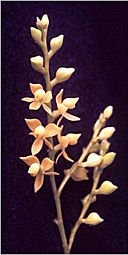

Epidendrum aquaticum Lindl. 1843 GROUP Aquaticum Photo by © Isabel Miller
TYPE Drawing by © Jimenez, Hágsater & E.Santiago and The AMO Herbario Website

 LATER
LATER
Common Name The Aquatic Epidendrum [refers to its often being found in boggy to very wet habitat]
Flower Size .56" [1.4 cm]
Found in Brazil at the edge of swamps or on cliffs near seepages at elevations of 700 to 800 meters as a medium sized, warm growing terrestrial or lithophyte with erect, cane-like, ancipitose, thin, slightly arching, branching, spreading at the insertion on the main stem, but then arching to an erect position, the base covered by non-foliar sheaths stems carrying alternate, narrowly lanceolate, light green, faintly keeled, coriaceous leaves that blooms in the later spring through fall on a terminal, erect, 1.4 to 2.2" [3.5 to 5 cm] long, shortly 3 branched, 1 to 7 flowered on each, few to 11 flowered inflorescence with shorter than the ovary, triangular, acuminate, margin entire, embracing floral bracts and carrying non-resupinate, the lip always facing the rachis, simultaneous, green flowers.
Similar to E dendrobioides and often cited as a synonym but occuring always near or in water, a much smaller plant and generally at lower elevations.
CAUTION The Photo above is most likely not E aquaticum but the drawing is most likely correct.
"Epidendrum aquaticum belongs to the GROUP Aquaticum which is characterized by the monopodial, branching habit, the distichous, erect to arching-nutant inflorescence, with fleshy flowers, and the disc of the lip and/or nectary often pilose. The species is recognized by the branching stems, branches 4 to 5" [10 to 12.5 cm] long, arching, leaves .52 to 2.04" [1.3 to 5.1 cm] x .16 to .24" [0.4 to 0.6 cm], lanceolate, glaucous below, inflorescence erect, distichous, simple to paniculate, flowers green, sepals .2 to .24" [5.0 to 6.0 mm] long, petals linear, .2 to .22" x .02 to .032" [5.0-5.5 mm x 0.5 to 0.8 mm], lip tri-lobed, base truncate, and callus rectangular with the apex truncate and slightly bilobed. Epidendrum dendrobioides Thunb. is also branching with branches 1.8 to 6.4" [4.5 to 16 cm] long, straight, sub-erect, leaves 1.4 to 2.4" x .2 to .32" [3.5 to 6.0 x 0.5 to 0.8 cm], linear-lanceolate, inflorescence distichous, generally simple, flowers ochre-yellow, sepals .24 to .3" [6.0 to 7.5 mm] long, petals linear-oblong, .22 to .24" x .4 to .48" [5.5 to 6.0 x 1.0 to 1.2 mm]. Epidendrum carnosum Lindl. also has branching stems, these about 6.4" [16 cm] long, sub-erect, straight, leaves 1.6 to 3.46" x .24 to .52" [4.0 to 8.6 x 0.6 to 1.3 cm], lanceolate, coriaceous and rigid, inflorescence generally paniculate, the branches sub-erect, flowers pale yellow to greenish yellow, sepals .36 to .4" [9.0 to 10 mm] long, petals lanceolate-rhombic, .32 to .36" x .06 to .1" [8.0 to 9.0 x 1.5 to 2.5 mm], and lip with a bidentate callus. Epidendrum pseudavicula Kraenzl. also has arching branches, but the leaves are .4 to 1.4" x .24 to .4" [1.0 to 3.5 x 0.6 to 1.0 cm], narrowly ovate to oblong-lanceolate, inflorescence simple to paniculate, flowers greenish yellow, sepals .2 to .24" [5 to 6 mm] long, and the base of the lip cuneate and bicallose, with a thin, short mid-rib in between." Hagsater etal 2018
Synonyms
References W3 Tropicos, Kew Monocot list , IPNI ; Orchidaceae Brasiliense Band 1 Pabst & Dungs 1975 drawing hmm; Icones Orchidacearum 3 Plate 345 Hagsater & Sanchez 1999 see recognition section; The Organ Mountain Range Its History and its Orchids Miller, Warren, Miller & Seehawer 2008 drawing/photo fide; Icones Orchidacearum 16(1) Plate 1604 Hagsater etal 2018 drawing fide; Icones Orchidacearum 16[1] Plate 1614 Hagsater & Santiago 2018 See Recognition section; Icones Orchidacearum 16[1] Plate 1649 Hagsater & Sanchez 2018 see recognition section;
--------------------------------------------------------------------------------------------------------------------------